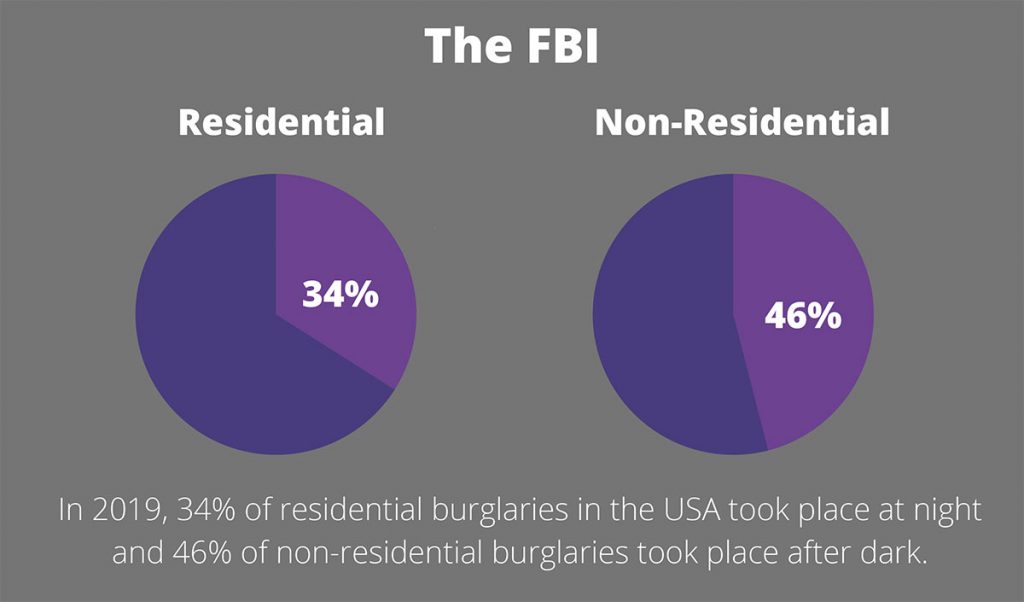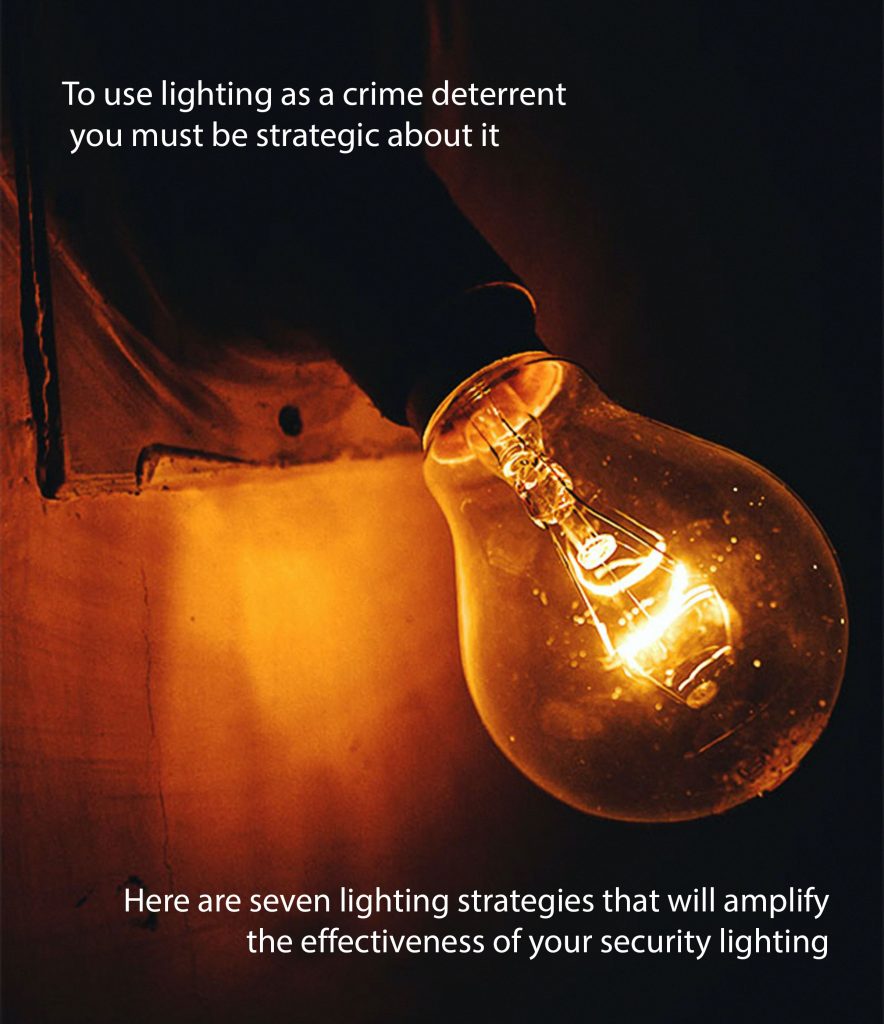A question I hear all the time is, ‘do outside lights deter burglars’? Yes, we all know that when you go out at night you should leave your lights on to deter criminals.
The question is…
Is this strategy at all effective?
In this post, I’ll reveal why a strategic use of lighting is one of the best burglar deterrents and how you can easily implement these lighting strategies in your home.
Lighting can be one of the most cost-effective security solutions for a home or business. It acts as a deterrent for crime and allows us to safely navigate pathways after dark.
It can even enhance an ailing CCTV system.
But before you make an online order that will brighten up your life, consider this. Not all lighting installations are made equal.
Despite a lighting installer’s best intentions, some lighting solutions do not deter crime, and in some cases, they may even aid criminals who are up to no good. With that in mind let’s look at a lighting strategy that will give you the maximum-security impact.
Home Burglary Statistics
For years, security experts have advised that lighting is an important part of home security, but is this a perception fueled by our innate fear of the dark, or is there sense in this guidance?
A brief look at some worldwide burglary trends show that while trends may differ in various countries, there is still a significant need to mitigate against after-dark burglary.
Australian Institute of Criminology’s Drug Use Monitoring Program (DUMA)

The Australian Institute of Criminology’s Drug Use Monitoring Program (DUMA), collected data from 228 burglary detainees. 41% of the detainees had been active burglars within 12 months of the study. According to their findings, 43,1% of the detainees preferred to commit a burglary between 6 pm and 7 am (after dark). When asked about what would deter a suspect from targeting a home, 19,3% mentioned lights inside a home and 22,8% included sensor lights as a deterrent.
British Office for National Statistics

A review of data supplied from the British Office for National Statistics looking at burglary from March 2010 to March 2020, shows that 65% of all burglary incidents took place after dark.
The FBI

In 2019, the FBI reported that 34% of residential burglaries in the USA took place at night and 46% of non-residential burglaries took place after dark.
Do Outside Lights Deter Burglars?
Lighting on its own is not a cure-all for burglary prevention, but when combined with other target hardening strategies such as home alarms, deadlocks and dogs, it becomes an essential part of a home security strategy.
Advice From Burglars

Michael Fraser, a well-publicized, reformed burglar from the UK, mentions the importance of motion-activated security lights.
But don’t just take Michael’s word for it.
In 2017, the Journal of Crime Science reported that a group of academic researchers had set out to establish whether the implementation of security devices could be linked to the drop in burglary incidents in England and Wales.
The researchers established that when homeowners used window locks, indoor lights on a timer, deadlocks, and external lights on a sensor, the risk of burglary reduced by almost 50 times.
However, it’s not just a case of putting up a few lights, putting away your ladder, and heading for the pub while you hope that when you return home, your TV will be just where you left it. In fact, it’s been established that badly applied lighting strategies can actually increase the vulnerability of a property.
Deep in the recesses of our mammalian brain lurks the fear of the dark. The answer to resolving this fear is the hope that flood-lighting will eliminate the potential dangers of things that go bump in the night.
However, continuous floodlighting has proven to be an ineffective security solution and a source of light pollution. This is especially true for business owners that want to protect public spaces.
In some studies, it was found that outdoor crime actually increased in brightly lit areas. Correspondingly, studies in the USA and New Zealand showed that there was no direct increase in crime when public space lighting failed or was removed.
Lighting can be one of the best deterrents for burglars. For it to be effective a little bit of strategy goes a long way.
Let’s look at security lighting in a little more detail:
Nine Security Lighting Tips to Use Lighting as a Crime Deterrent
To use lighting as a crime deterrent, you must be strategic about it. Here are seven lighting strategies that will amplify the effectiveness of your security lighting.

Start Your Planning by Using the Adversarial Mindset
Being visual creatures, our visual sense plays an essential role in our ability to detect danger. A well-placed external light greatly enhances our situational awareness.
Security lighting offers the dual function of becoming a detection mechanism and a deterrent.
When planning your lighting, look at your home from the outside as if you were a prospective thief, then reverse the exercise.
Go inside and look out from the window. Where would you need the light to be so that it would be easy to detect movement? If you were a burglar, you would want to spend minimal time being visually exposed.
In the worldwide statistics mentioned above, the most common point of entry is via the front or back doorway.
So, it stands to reason that anyone approaching a doorway needs to be bathed in light. Cover the routes of access and security-critical areas with your lighting plan. Consider your front and back door, driveways, perimeter areas, the sides of the house, and walkways.
Use Motion-Activated Lighting
Motion-activated lighting is an effective security deterrent because if functions as a call to action.
When a light turns on, so should your sense of vigilance. Place your lighting in positions that will highlight the path of an intruder.
It is important to purchase a system that allows you to adjust the sensitivity of the sensor. Once your light is up, step out into the night and test the light.
You want to reduce the sensitivity of the light activation as much as possible to decrease false activations. Beware of placing the light in front of bushes and tree branches that will activate the light as they wave in the wind.
Augment Your Outdoor Alarm System with Lighting
Motion-sensitive lighting can enhance an alarm system that is equipped with outdoor passive detectors.
Place your lighting in a position that will allow it to illuminate the area the alarm is monitoring. Additionally, some modern security systems allow for lighting and alarm systems to activate together.
In this way your intruder is getting a double sensory whammy. Siren and bright lights all in one.
If your alarm activates, move to a safe position at a window and monitor what has activated the alarm.
Purchase Lights That Have Shields to Eliminate Glare
As a rule, people from the international space station don’t need to know where you live. You only want the light to illuminate the security sensitive area.
Angle the light so that it gives you maximum security value and reduces light pollution. It’s also important to eliminate glare that will blind you. You want to comfortably glance at an area and easily see movement.
Mount Your Lights at the Correct Height

Powerful lighting that is mounted too high can create severe shadows. Conversely, lighting that is mounted too low reduces the area of coverage.
You are aiming to illuminate the area with a shadow free soft glow. Depending on the area, ideal light height varies from 6 to 10 feet above the ground (that’s 1.8 to 3 meters for metric readers that have left the imperial age).
Protect Your Security Lighting System
Lights can come under attack from criminals and from the elements. Where long areas of cabling are needed, place your cabling in plastic conduit.
Place junctions and power sources in sealed boxes that are out of reach and are waterproof. Using wireless solar-powered systems circumvent the problems associated with lightning strikes and cabling that will inevitably become aged or damaged.
Go Green with Your Lighting
Motion sensitive lights are already a step to save electricity. Nowadays it’s also possible to get a range of quality LED and solar-powered external lights.
LED systems draw less power, last longer, and can create an ideal white light needed for security.
Solar-powered systems keep you secure even when the power grid is down and eliminate the need to run long reels of cable to your perimeter areas. Remember to position the solar cell in a place where it will get sufficient light to charge during the day.
Enhance Your CCTV System

Be it a poor, moderate or high-quality system, one of the most significant limits to a CCTV installation is lighting.
Cameras that can see well beyond 50 meters (164 ft) in the day, may not even cover half of that distance after dark.
Aside from thermal systems, most modern cameras illuminate an area by using infrared lighting. Therefore, at night a camera can only see as far as the reach of the infrared light.
Adding conventional lighting or even infrared illuminators can extend the monitoring distance of your CCTV system in the hours that you need those cameras the most.
Be careful not to place lights opposite cameras as this can create a glare in the camera image and even blind parts of the camera view. It is best to put the light on the same side as the camera and point it in the same direction that the camera is pointed.
Assist Your Neighborhood Patrollers
Security officers and police spend hours patrolling dark streets. At times, its necessary to stop and use a spotlight to check a yard for movement.
A well-placed light can make it easy for the thin blue line to check that your yard is secure. To select the position of these lights, drive up to your property at night and assess it from the street side.
Note which areas are visible from a vehicle and then consider how you could illuminate these areas. Once again fall back on the adversarial mindset.
If you were a thief, and you heard a car coming, you would dash into a nice dark spot until the car has passed. That’s the spot to illuminate.
References
Clark, B. A. (2003, 05 23). OUTDOOR LIGHTING AND CRIME, PART 2:. Retrieved from http://www.asv.org.au/: http://amper.ped.muni.cz/light/crime/OLCpt2.htm#_Toc50355955
FBI. (2019). Crime in the U.S. 2019. Retrieved from FBI:UCR: https://ucr.fbi.gov/crime-in-the-u.s/2019/crime-in-the-u.s.-2019/tables/table-23
Gately, N., Fleming, J., McGinty, N., & Scott, A. (2014). The ‘oldest tricks in the book’ don’t. Trends and Issues in Crime and Criminal Justice, 489.
Motion Light Location You Might Not Have Thought Of…. (2019, Jan 9). Retrieved from Moder Survival Blog : https://modernsurvivalblog.com/security/best-locations-for-security-motion-lights/
Murphy, A. (2019, Feb 20). Adversarial Mindset: Home Defense. Retrieved from The Secure Dad : https://www.thesecuredad.com/post/adversarial-mindset-home-defense
Office for National Statistics . (2020, February 13). Homicide in England and Wales: year ending March 2019. Retrieved from Office for National Statistics : https://www.ons.gov.uk/peoplepopulationandcommunity/crimeandjustice/articles/homicideinenglandandwales/yearendingmarch2019#what-were-the-most-common-methods-of-killing
Tseloni, A., Farrell, G., Thompson, R., Evans, E., & Tilley, N. (2017). Domestic burglary drop and the security hypothesis. Crime Science.
